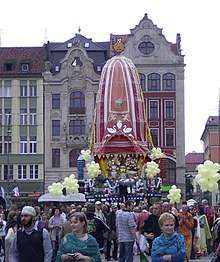Indians in Poland
Indians in Poland consist of migrants from India to Poland and their locally born descendants. The estimations of number of Indians in Poland vary from 4,000 by governmental sources [3] [4] [5] to 15,000.[6]
| Total population | |
|---|---|
| from 4,000 (2014)[1] to 15,000[2] | |
| Regions with significant populations | |
| Warsaw · Łódź · Pabianice | |
| Languages | |
| Polish · various languages of India · English | |
| Religion | |
| Hinduism · Sikhism | |
| Related ethnic groups | |
| People of Indian Origin |
Migration history
Indians started migrating to Poland in the late 1980s and early 1990s when the political situation changed and new opportunities started to emerge.[7] Most of them are businessmen who migrated to cash on the economic boom after Warsaw opted for a free-market economy in 1989 and joined the European Union in 2004. In 2007, Poland signed an agreement with India to admit more Indian migrant workers, as part of an effort to ameliorate labour shortages caused by the outward migration of hundreds of thousands of Polish workers to richer countries in the European Union.[8] New important group of Indians in Poland are students and academics.[9] Recent research shows that the Indian community is quite well integrated in the Polish society.[10]
Number of work permits for Indian citizens and number of Indian students enrolled in Polish universities
| Year | Total number of work permits for foreigners issued [11] | Of which for Indians (%) | Number of work permits for Indian citizens* | Academic year | Number of Indian students enrolled in Polish universities |
|---|---|---|---|---|---|
| 2010 | 36 800 | 3,2 | 1 189[12] | 2009-10 | 227[13] |
| 2011 | 40 808 | 2,6 | 1 055 | 2010-11 | 148 |
| 2012 | 39 144 | 2,78% | 1 088 | 2011-12 | 189 |
| 2013 | 39 078 | 3,33% | 1 301 | 2012-13 | 204 |
| 2014 | 43 663 | 2,84% | 1 240 | 2013-14 | 321[14] |
| 2015 | 65 786 | 2,17% | 1 428 | 2014-15 | 545[15] |
| 2016 | 127 394 | 1,39% | 1 771 | 2015-16 | 896[16] |
| 2017 | 235 626 | 1,61% | 3 794 | 2016-17 | 2 138[17] |
| 2018 | 328 768 | 2,54% | 8 362 | 2017-18 | 2 987[18] |
| 2019 | * | *% | * | 2018-19 | 3600 (preliminary data) |
- (calculated on basis of col. 1 and col. 2)
Culture
The Indian community in Poland is a business minded community. They have their own 'Little India' in Warsaw and Krakow as a large number of the community are based there while there are others based in Łódź and Pabianice.
Religion

Hindus and Sikhs form the majority of the Indian community. Hinduism has spread to Poland through ISKCON missionaries since 1976. The first Polish Hindu temple was established in 1980 in Czarnów, Lower Silesian Voivodeship (New Shantipur Temple in Czarnów).[19] A new Hindu Temple named the Hindu Bhavan was constructed in Warsaw.[20] The Indian community hopes that the temple sensitizes the community's youth towards Indian tradition and customs as well as to use the new place of worship as a tool to integrate with Polish society.
There are about 120 Sikh families in Warsaw.[21] The city's Sikh Gurdwara the only Sikh shrine in the whole of Eastern Europe and it is the place where both Sikhs and Sindhis come together to celebrate Baisakhi.
References
- Pędziwiatr, K., Kugiel, P. (2014) The Indian Diaspora and Poland–India Relations. PISM Report p.5
- Indian Community of Poland
- Ministry of External Affairs, India (2018) Population of Overseas Indians p.5
- Pędziwiatr, K., Kugiel, P. (2014) The Indian Diaspora and Poland–India Relations. PISM Report p.5
- Namaste-Polsko, Sytuacja i potrzeby imigrantów z Indii w Polsce. Iwona Bąbiak, Katarzyna Gmaj (ed) (2015) Namaste-Polsko p.79
- Indian Community of Poland
- Kontynent-Warszawa- On Indian community in Warsaw
- Poland: The Next Hot Destination for Indians
- Pędziwiatr, K., Kugiel, P. (2015) Poland as a Study Destination: The Case of Indians at Polish Universities, In: Surdej, A., Kędzierski, M., (ed.) Economic Challenges for Higher Education in Central and Eastern Europe, Wydawnictwo Adam Marszałek, Toruń, 187-213
- Pędziwiatr, K., Kugiel, P. (2014) The Indian Diaspora and Poland–India Relations. PISM Report
- "'Informacja o zatrudnieniu cudzoziemców w Polsce, 2018, Ministry of Family, Labour and Social Policy, Table 2 and 3, p. 2'". psz.praca.gov.pl. Retrieved 18 May 2019.
- Namaste-Polsko, Sytuacja i potrzeby imigrantów z Indii w Polsce. Iwona Bąbiak, Katarzyna Gmaj (ed) (2015) Namaste-Polsko p.16
- Namaste-Polsko, Sytuacja i potrzeby imigrantów z Indii w Polsce. Iwona Bąbiak, Katarzyna Gmaj (ed) (2015) Namaste-Polsko p.18
- "'Report „Studenci zagraniczni w Polsce 2014"'". perspektywy.pl. Retrieved 18 May 2019.
- "'Report „Studenci zagraniczni w Polsce 2015"'". perspektywy.pl. Retrieved 18 May 2019.
- "'Report „Studenci zagraniczni w Polsce 2016"'". perspektywy.pl. Retrieved 18 May 2019.
- "'Report „Studenci zagraniczni w Polsce 2017"'". studyinpoland.pl. Retrieved 18 May 2019.
- "'Report „Studenci zagraniczni w Polsce 2018"'". prenumeruj.forumakademickie.pl. Retrieved 18 May 2019.
- Polish ISKCON history (in Polish), accessed 2010.8.4
- Pakistan Hindu Post - Poland to get a Hindu temple by August
- Thaindian News - Indian community celebrates Baisakhi in Poland